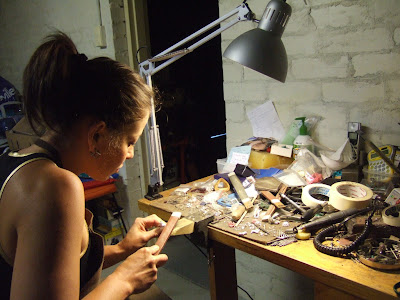 Tell us about yourself…
Tell us about yourself…
I grew up in Melbourne, the middle child of three girls. My English father descended from a long line of artists, collectors and eccentrics and was a Japanese Prisoner of War, after his naval ship was torpedoed in World War 2. My Chinese mother descended from a Malaysian rubber plantation dynasty and was schooled in a convent. You couldn’t have found two people more diametrically opposed and their marriage was nothing short of a cultural and generational collision.
I was always good with my hands… whether climbing trees, strangling my sisters or making miniature twig bow and arrows to shoot up the classroom aisle. Even the principal couldn’t help but admire my handiwork. My killjoy parents had banned TV, so we had to create our own amusement. We were pretty crafty kids, always sticking and pasting or making something-or-other…pasta necklaces, papier mache piggy banks, matchstick houses, even hideous macramé owls and wall hangings that first graced, then insulted, our lounge room walls. My Chinese grandmother, who lived with us throughout our childhood, was a keen artist and needlework expert and kept us busy with a continuous array of implausible sewing projects. My adored stepfather had no qualms about using child labour to fix and maintain the decrepit house and car. These were my earliest lessons in construction.
Fresh out of high school and momentarily adopting a serious tone, I started a Psychology Degree, taking a casual weekend job in Imported Fashions at David Jones. By the time I completed my studies, I was almost up for long service leave and had developed a frightening penchant for couture clothing and accessories. A sucker for beautiful fabrics, excessive adornment and clever design, I caught the twenty-something travel bug and headed to London on a one-way ticket, with shopping in mind… I wantonly lost myself in her crazy melting pot for the next decade, lurching recklessly through my formative years.
I returned to Australia with my tail between my legs and a beautiful son in tow. With restless hands, no home of my own to dismantle and no closer to divining my higher calling, my sister cleverly suggested we try a short course in jewellery making. It felt instantly familiar, like coming full circle. After my countless creative endeavours, it was a relief to discover that the immediacy & expressiveness of jewellery was by far, the best suited to my impatient, fickle nature.

Vanessa at her workbench
The jewellery you make often contains geometric shapes and hard lines. Is this something you’d like to keep exploring as a signature style, or are your aesthetics still evolving?
I love the clean, predictable lines of geometric shapes, combined with their brutal edges and attention-seeking three dimensionality. I wouldn’t say it’s my signature style as such, although admittedly I have experimented with geometric themes for several ranges to date. As the permutations and combinations are virtually endless, I still have quite a bit of exploring to do! Generally speaking, my aesthetic is very scattered and diverse and I am equally drawn to organic as well as industrial forms. I suspect that further down the beaten track, my style will branch off in all sorts of wayward directions, as my experience and aesthetics evolve. 
Who are some of your favourite jewellers/artists?
My favourite jeweller/sculptor thus far, is probably David Watkins. Other jewellers that do it for me are Mari Funaki, Giampaolo Babetto and Hiromasa Hashimoto… I wouldn’t be at all surprised to find that I haven’t even discovered my true favourites yet. I am also greatly inspired by the work of Spanish architect/engineer, Santiago Calatrava.
Apart from metal, are there any other materials you’d like to eventually start using?
Yep, lots! I would love to experiment with bone, resin, acrylic, enamel, leather, textiles and threads, mixing materials and techniques with metal to create sensual, textural contrasts. A sentimental collector of found and abandoned objects, I nurture an imagined kinship with these little forms and would love to incorporate them in my personal jewellery collection, once I stop procrastinating.


Vanessa's work space
What is Melbourne’s best kept secret for you?
As Melbourne’s self-appointed Hard Rubbish Queen, it would have to be Camberwell Market, at the crack of dawn, after a messy night out, armed with a hands-free flashlight. My next favourite place would be ‘de Mille’, in Crossley Lane in the city, a vintage shop full of quirky collectables. ‘All Aboard’ on the Bellarine Highway is another Hoarder’s Heaven which I can highly recommend… three decommissioned trams crammed full of vintage delights and the courtyard bursting with rusty chains, augers, wheels, windmills and wagon parts…. because of course, one can never have enough stuff.

And finally, what gets you in the mood to make and create?
Lots of things, particularly listening to my favourite tunes. I do look at the world very differently now, always in terms of construction and I seem to see everything through jewellery coated lenses. I sketch or photograph whatever inspires me and I often dream of new ideas just before I wake. I try to scribble them down before I forget, though sometimes I simply cannot remember and it drives me ‘round the bend.

Vanessa Maxim also recently exhibited as part of group show SNEAK (enCOUNTER, 16 November - 6 December 2009). Click here to view more images from the exhibition.





 Adam: "The weight of expectation is too heavy on my frail shoulders."
Adam: "The weight of expectation is too heavy on my frail shoulders." 




















 Mae Finlayson
Mae Finlayson  Spin Spin (Susan Fitzgerald)
Spin Spin (Susan Fitzgerald)
 Gemma Johnson
Gemma Johnson









 Tara Lofhelm
Tara Lofhelm











